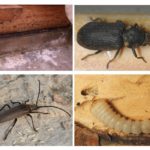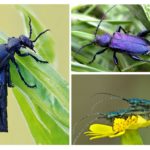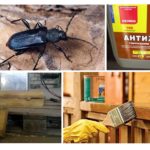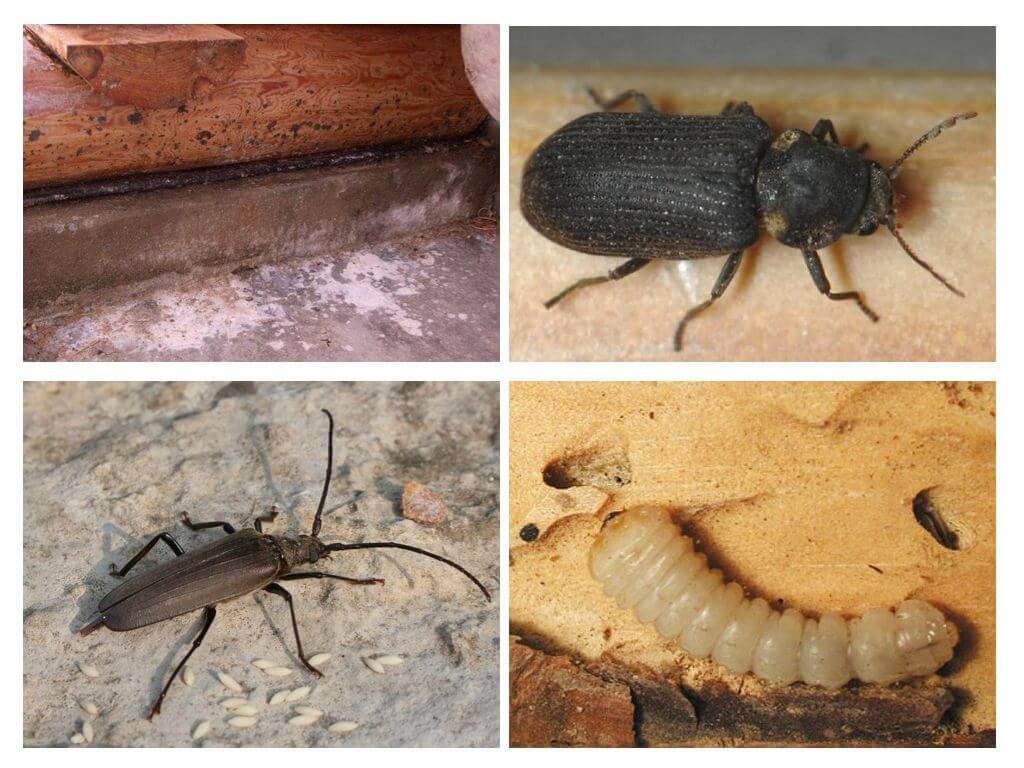How to get rid of the beetle beetle
Content
- Black Brown Barrel
- Purple barbel
- Fighting beetle
Despite the fact that wood is not too filling material, there are hunters who want to eat it. This is about barbel beetles or as they are called lumberjacks, which cause enormous harm to wooden structures. There are a great many species and subspecies of these pests - this is a purple barbel, a furniture grinder, and a black barbel tree. There are also bad breeds and drillers.All of them damage the wood, the consequence of which is the weakening of the structure of the house, and sometimes its destruction.
Features of barbel beetles
Not everyone knows how dangerous the borer beetles are. Most of them are dying trees. But there are insects who prefer to settle exclusively in dead wood. These include the purple beetle barbel and the black housebelly barbel.
Black Brown Barrel
Black brown barbel is widely distributed in Europe, in China, Siberia and the Caucasus. The beetle has a flat black elongated body, which can be as long as 2.5 cm. On a large head, relatively short mustaches grow (they do not reach even to the middle of the body). The heart-shaped shield covers the delicate white hairs. Slightly convex elytra are located on the back of the brown mustache, gradually tapering towards the apex. The insect has two pairs of well-developed legs and two shiny spots on the pronotum. The photo of the house maniac is presented below.
On a note!
The habitat of the black house mustache is the elements of houses made of coniferous trees (window and door frames, floors, various beams, rafters of roofs, pillars and floors).The female, penetrating into the cracks of the wood, lays in it from 50 to 400 eggs, of which after 14–20 days, the larvae differing in great appetite appear.
The length of the body of an adult larva of the black woodworm can reach up to 2 cm. Its distinctive features are strong jaws and 3 vertically arranged eyes. Bright shiny body covered with barely noticeable cilia.
Black woodcutter larvae gnaw winding passages, moving deep into the fibers and destroying the wood structure of the house. As a result, the surface layer of wood products becomes very thin. This is evidenced by the appearance of brown wood flour and pest excrement. Already, young beetles are emerging outside, leaving holes with a diameter of 6–12 mm.
Purple barbel
Flat purple barbel is another representative of the beetle group. The length of its body does not exceed 1.5 cm. More often, the beetle has a purple or dark blue color, less often a green surface. The entire body of the insect is covered with erect hairs. The purple pest has a flat chest shield and wide wrinkled elytra. Antennae, which are much shorter than the body, and the legs of the insect are chestnut-brown in color.
Purple barbel dominates mainly in dead wood, dead wood, and also in timber in warehouses. It feeds exclusively on pine, rarely spruce, sometimes populates larch and fir. The beetle starts where the bark is at least partially preserved. On its surface, it gnaws winding passages. This representative can also be found near private houses, damaging wooden buildings, hedges and poles. Distributed in Russia, Western Europe, Siberia and the Caucasus.
Females lay eggs in the cracks of wood bark from 1 to 5 pieces. After 2 weeks, broad and rather flat larvae appear from them, the white body of which is covered with dense setae. In length, the larva grows up to 2.5 cm, its dimensions in width can reach up to 6 mm. Well-adapted jaws help her to gnaw wood.
Interesting!
It is surprising that the barbel beetle uses only 20% of the total amount of wood damaged by it.
Signs of the presence of pests
The following signs may indicate that a beetle was wound up in a house, as follows:
- the presence of small holes and passages on the surface of the wood;
- rustling, clicking and ticking - such characteristic sounds are made by barbel beetles, gnawing in the wood of the house moves;
- brown or yellowish powder (drill flour);
- the presence of the pests themselves flying through the house.
Therefore, when these symptoms are detected, it will not be superfluous to know how to get rid of the beetle beetle in a wooden house.
Ways to fight
The main reason for the appearance of a harmful insect in the house is contaminated material, which was used to build a house or a household building. If such a fate befell your possessions, then it is urgent to take measures to get rid of the pest. After all, only a timely fight with a bug with a barbel will help save the house.
- Antifungal agent. They process the surface of the house in dry weather.
- With a small number of single holes, in the absence of rotting and destruction of wood, you can use the method of douching. To do this, the insecticidal solution is injected into the detected passages with a syringe or a small oil can. For this purpose, petroleum jelly can also be used. After the introduction of the oil mass in the hole, it is necessary to pour paraffin wax or.
- With a large number of winding paths, the method of douching can be enhanced by impregnating the surface with the same insecticide. To obtain the maximum effect, you should capture some of the undamaged areas of wood. After that, all the "houses" of pests must be sealed with any dense putty.
- Remove infected areas. With the massive infection of wooden elements will have to replace them with new ones.
- The method of temperature exposure. Freezing or heating of individual elements in a special chamber will help get rid of tree borers. The disadvantage of this method is the lack of the possibility of carrying out such a process on surfaces that are larger in terms of area.
- Fumigators - another means of dealing with wood borers in the house. So the smell of phosphine does not like the larvae of the barbel. In this connection, the use of this chemical can only be used inside the house.
- Method of microwave pest control. Microwave radiation generated by a microwave installation destroys baleen insects at various stages of their development. The use of this method does not require the evacuation of people and pets.
Do not have to get rid of beetle beetles, if timely carry out preventive treatment of a wooden house. To do this, use protective equipment - antiseptics of complex values such as Pinotex, Phoenix or Senezh. Insects will not live in the wooden elements of the house if they are plastered.
In order not to have to deal with the purple barbel, it is necessary to periodically clean the dead wood, and also to properly store the wood in accordance with sanitary rules.











